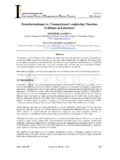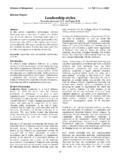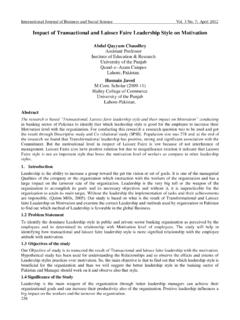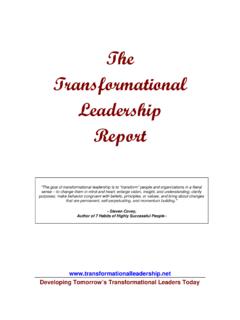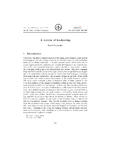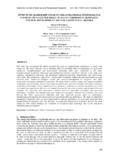Transcription of Transformational and Transactional Leadership: A Meta ...
1 Transformational and Transactional leadership : A Meta-Analytic Test ofTheir Relative ValidityTimothy A. Judge and Ronald F. PiccoloUniversity of FloridaThis study provided a comprehensive examination of the full range of Transformational , Transactional , andlaissez-faire leadership . Results (based on 626 correlations from 87 sources) revealed an overall validityof .44 for Transformational leadership , and this validity generalized over longitudinal and multisourcedesigns. Contingent reward (.39) and laissez-faire ( .37) leadership had the next highest overallrelations; management by exception (active and passive) was inconsistently related to the , there were several criteria for which contingent reward leadership had stronger relationsthan did Transformational leadership .
2 Furthermore, Transformational leadership was strongly correlatedwith contingent reward (.80) and laissez-faire ( .65) leadership . Transformational and contingent rewardleadership generally predicted criteria controlling for the other leadership dimensions, although trans-formational leadership failed to predict leader job the past 20 years, a substantial body of research has accu-mulated on Transformational Transactional leadership (1978) first introduced the concepts of Transformational andtransactional leadership in his treatment of political leadership .
3 AsConger and Kanungo (1998) noted, to Burns the difference be-tween Transformational and Transactional leadership is in terms ofwhat leaders and followers offer one another. Transformationalleaders offer a purpose that transcends short-term goals and fo-cuses on higher order intrinsic needs. Transactional leaders , incontrast, focus on the proper exchange of resources. If transfor-mational leadership results in followers identifying with the needsof the leader, the Transactional leader gives followers somethingthey want in exchange for something the leader wants (Kuhnert &Lewis, 1987).
4 To Burns, Transactional leadership is more common-place than is Transformational leadership , if less dramatic in (1985) based his theory of Transformational leadership onBurns s (1978) conceptualization, with several modifications orelaborations. First, Bass did not agree with Burns that transforma-tional and Transactional leadership represent opposite ends of asingle continuum. Bass argued that Transformational and transac-tional leadership are separate concepts, and further argued that thebest leaders are both Transformational and Transactional .
5 Second,Bass elaborated considerably on the behaviors that manifest trans-formational and Transactional leadership . Although the theory hasundergone several revisions, in the most recent version there arefour dimensions of Transformational leadership , three dimensionsof Transactional leadership , and a nonleadership four dimensions of Transformational leadership are cha-risma or idealized influence, inspirational motivation, intellectualstimulation, and individualized ,orideal-ized influence,is the degree to which the leader behaves in admi-rable ways that cause followers to identify with the leader.
6 Char-ismatic leaders display conviction, take stands, and appeal tofollowers on an emotional motivationis thedegree to which the leader articulates a vision that is appealing andinspiring to followers. leaders with inspirational motivation chal-lenge followers with high standards, communicate optimism aboutfuture goal attainment, and provide meaning for the task at stimulationis the degree to which the leader chal-lenges assumptions, takes risks, and solicits followers with this trait stimulate and encourage creativity in considerationis the degree to which theleader attends to each follower s needs, acts as a mentor or coachto the follower.
7 And listens to the follower s concerns and from its central role in Transformational leadership theory,charismatic leadership has been the basis of its own distinctliterature. Weber (1921/1947) was the first to discuss the implica-tions of charismatic leadership for organizations. House s (1977)theory of charismatic leadership was the first to use the concept incontemporary organizational research. Since that time, there havebeen many studies of charismatic leadership ( , House, Spang-ler, & Woycke, 1991; Howell & Frost, 1989; Shamir, Zakay,Breinin, & Popper, 1998).
8 As we note later, it is clear that trans-formational leadership and charismatic leadership theories havemuch in common, and in important ways, each literature hascontributed to the three dimensions of Transactional leadership are contingentreward, management by exception active, and management byexception rewardis the degree to which theleader sets up constructive transactions or exchanges with follow-ers: The leader clarifies expectations and establishes the rewardsfor meeting these expectations. In general, management by excep-tion is the degree to which the leader takes corrective action on thebasis of results of leader follower transactions.
9 As noted by How-ell and Avolio (1993), the difference betweenmanagement byexception activeandmanagement by exception passivelies inTimothy A. Judge and Ronald F. Piccolo, Department of Management,Warrington College of Business, University of concerning this article should be addressed to TimothyA. Judge, Department of Management, Warrington College of Business,University of Florida, Box 117165, Gainesville, FL : of Applied PsychologyCopyright 2004 by the American Psychological Association2004, Vol. 89, No. 5, 755 7680021-9010/04/$ DOI: timing of the leader s intervention.
10 Active leaders monitorfollower behavior, anticipate problems, and take corrective actionsbefore the behavior creates serious difficulties. Passive leaderswait until the behavior has created problems before taking final form of leadership , actually nonleadership, is laissez-faire is the avoidance or ab-sence of leadership . leaders who score high on laissez-faire lead-ership avoid making decisions, hesitate in taking action, and areabsent when needed. Although laissez-faire leadership bears someresemblance to management by exception passive leadership ,researchers have argued that laissez-faire leadership , because itrepresents the absence of any leadership ( Transformational or trans-actional), should be treated separately from the other transactionaldimensions (Avolio, 1999; Bass, 1998).

